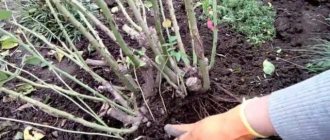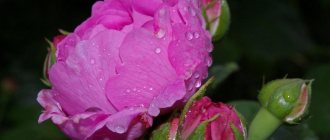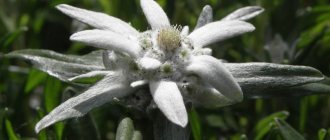Roses are rightfully considered the queens of flowers; their sophistication, tenderness and aroma do not leave anyone indifferent. A bouquet of roses is a win-win option for congratulations; what could be better than that? Only live, not cut roses. Recently, this option for a floral gift has become very popular and miniature roses in pots are the best gift option for any occasion. But what to do with them next, how to care for them so that they bloom and please the eye for a long time?
What are miniature roses
This is a group of varieties that are small in size, reaching no more than 40-50 cm in height. The bushes are quite spreading, with a lot of leaves. Their numerous flowers are usually small in size. Miniatures are most often sold in stores as gift or balcony roses. They can be grown in containers and used in the design of rooms, balconies, terraces, and festive decorations of the hall.
Miniature roses are also grown in gardens. They look great, for example, as low carpets or borders. Due to their small size, mini roses can be grown as indoor flowers. They have become a popular small gift that can be given on a variety of occasions such as name days, birthdays, anniversaries or simply as an expression of appreciation. Potted roses are more durable than cut flowers. Instead of just a few days, they will delight with their flowering for many months, and with proper care, even years.
Miniature roses sold by florists are often delayed in growth by special preparations. Therefore, they are much smaller (10-20 cm) than the same varieties when grown naturally. The effect of dwarfism lasts up to several months. In the following growing seasons, miniature roses reach normal sizes, that is, 40-50 cm. Their flowers and leaves are correspondingly larger.
This is not the only surprise that can happen with a small rose bush received as a gift. Sometimes these roses also change colors. For example, in the first months they are red, and in subsequent seasons they are orange. This is also the effect of using special drugs. The natural color in the described case is orange. The red color is the result of treatments aimed at making the rose attractive for sale.
It is worth remembering that a rose is a shrub adapted to life in the open air and it needs winter dormancy at low temperatures. Therefore, it is difficult to grow a rose on a windowsill in an apartment for years, although it is theoretically possible.
The best varieties of miniature roses: photos and descriptions
Currently, the following are considered the best varieties of miniature roses.
“Orange Jewel” - salmon-orange flowers, large, densely double, noble in shape, do not fade for a long time. The bush is strong, compact, and grows easily. The height of this variety of miniature roses is 30 cm.
“Amulet” - flowers of a rich pink-red color, large, densely double. The foliage is green. The bush is dense, quickly growing, healthy. This variety is famous for its charming flowers, as well as its abundant and long-lasting flowering. Height - 50 cm.
"Little Baccarat" is a low (up to 25 cm) bush, spreading. The leaves are shiny with a bronze tint. The flowers are semi-double, red-crimson with a white center. They have a pleasant smell.
"Baby Baccarat" - distinguished by the ideal shape of the flower, velvety red, almost black.
“Pomegranate” is a densely leafy bush, durable, shiny, dark leaves, abundant flowering. The flowers are large (up to 5 cm in diameter), ideally shaped, crimson-red.
Common varieties "Baby Carnival" with pink-red flowers,
“Pixie”, “White Jam” - with white ones,
"Eleanor" - with coral pink.
This selection contains photos of the best varieties of miniature roses:
Diseases
Are there dark spots on the shoots of the rose? This could be necrosis, find out how to save the plant
Bark necrosis on roses
Does the rose begin to wither and die for no apparent reason? It could be root rot, find out control and prevention measures
Root rot of roses
Girdle spots of brick and burgundy shades appear on the shoots of roses, find out why this happens
Infectious rose burn
Are there growths and cracks on the rose? It could be cancer, read what to do next
Common rose cancer
If you received a miniature rose as a gift or bought one from a flower shop, place it in a well-lit place, but not in direct sunlight, “East” or “Southeast” is best. When placed on the south side, during the day they need to be shaded from the scorching sun.
- Choosing a pot. For the shortest varieties, growing up to 35 cm, a pot with a height of 20-30 cm is sufficient. For larger ones, you need to take a pot of about 50 cm, but for all plants it is important that each pot has a hole in the bottom, as well as a drainage layer (pebbles , expanded clay, coarse gravel). This will prevent the roots of the roses from standing in water, which is very harmful for them. The pot should be large, preferably with double walls (they protect against excessive freezing and heating of the soil and drying out). It is better to plant miniature roses outdoors no later than August. Thanks to this, they will gradually go into a dormant state - they will become woody, stop blooming and shed their leaves. In addition, they will take root better before winter.
- Substrate selection. Miniature roses purchased in the store are already planted in special substrates with the addition of long-lasting fertilizers. Such substrates dry out quite quickly, so you need to take care of systematic watering. Since the volume of the pot is small, the nutrients run out quite quickly. Therefore, roses should be replanted in fresh soil and larger pots. They tolerate this procedure very well during flowering. For planting and replanting roses, it is best to use a specialized substrate; it must be fertile, preferably with humus, light, breathable and slightly acidic. Proper pH (pH 5.4-6.2) ensures proper growth, lush flowering and greater disease resistance.
- Transfer time. It is best to replant roses 3-4 weeks after purchase, but here you need to take into account the time of year, because miniature roses are sold all year round, including in winter. Of course, the winter months are not the best time for roses to bloom in our climate. These are specimens grown in greenhouse conditions. Therefore, it is better to postpone their transplantation until the turn of winter and spring. In winter, bushes are replanted solely when necessary, for example, when the root ball has grown so large that it “crawls out” of the pot and dries out very quickly.
- Watering. The rose loves moderate but constant humidity, so we water it often, but not too much. The water in the pan should not stagnate.
If possible, it is best to transplant a miniature rose into the garden. It would also be a good idea to place it on the balcony.
Growing roses in apartments is more difficult because in winter they are too warm and dry. As a result, roses do not “go to sleep” for the winter, which makes them weaker and more often affected by diseases and pests. If possible, provide them with rest in a cool area, such as an unheated room. It is better for them to spend the summer outside, for example, on a balcony or terrace.
Why indoor miniature roses dry out and how to prevent this you will learn from the video.
Diseases and pests
Home roses can be affected by diseases and pests such as:
- Chlorosis. The appearance of this scourge can be recognized by yellowed leaves. Iron chelate effectively combats chlorosis.
- Powdery mildew. Its appearance is indicated by white spots on the leaves and stems of the plant. Fungicides are used for treatment.
- Spider mite. This pest leaves a thin web between the leaves. To combat it, the drugs Fitoverm and Apollo are used.
- Thrips and aphids. Deformation of the leaves and flowers indicates that the plant is infected by these pests. For treatment, insecticides for indoor plants are used.
Pests
Microscopic spiders have appeared on the plant, and the rose is gradually becoming covered with cobwebs, what should I do?
Spider mite
Are small green insects destroying your rose? Effective methods of pest control.
Green rose aphid
Caterpillars have appeared on the rose and are twisting the leaves of the plant, how to deal with the pest
Rose leaf roller
Flat bumps have appeared on the shoots of the rose or on the underside of the foliage, how to deal with the pest
Rosen scale insect
Reproduction of dwarf roses
The miniature beauty is propagated by cuttings - the middle part of the shoots. If the rose grows in open ground, cuttings are best done at the end of May or during June.
Cutting procedure:
- It is recommended to choose shoots with three buds.
- The stem is cut at an acute angle under the bud from below and above it from above.
- The cuttings are dipped for several hours (8-10) in the Epin nutrient solution. Proportions of the solution: 100 g of the drug is diluted per 1 liter of water.
- Afterwards, the cuttings are planted in prepared soil in a box.
- The first layer requires good drainage, consisting of sand, gravel or expanded clay.
- Ordinary garden soil is laid out on it. It is advisable to sprinkle the soil with a layer of sand.
- Cuttings are planted often and covered with film.
In the first month the plant should be in conditions of high humidity. In the second month, the box can be ventilated periodically. The rooted cuttings begin to bloom profusely only in the second year. For the winter, the cuttings are covered in the same way as an adult plant with the help of coniferous spruce branches and insulation with film.
How to fertilize miniature roses
Florists provide ideal conditions for flowers. When preparing plants for sale, they are planted in specially prepared soil, which contains enough nutrients for several weeks. In order for them to continue to actively bloom and not lose their decorative effect for a long time, they need to be periodically fed with fertilizers. Lack of nutrition immediately affects the general condition of the rose, their leaves become smaller, turn pale, and flowering weakens.
Miniature roses are fertilized every two weeks from spring to August. The best fertilizers are those that are formulated specifically for roses. For miniatures planted in pots, liquid preparations are most convenient, for example “Fasco Flower Happiness”. Its cap is also a dispenser. The measured dose is poured into a watering can and watered over the rose.
Long-lasting fertilizers are also very convenient. For example, it is enough to apply Kemira Universal fertilizer once in the spring. It comes in the form of granules, the ingredients of which are released gradually, depending on humidity and temperature.
It is very convenient to use drugs in capsules, for example Magic Grow. This drug contains nutrients and a growth activator. Simply break off the tip of the self-distributing applicator and stick it into the substrate. A specially selected composition ensures lush flowering of plants and healthy leaves for two months. The flowers have a rich color.
Care
Miniature roses require care, including watering, fertilizing and pruning bushes.
.
Water the plants by sprinkling twice a day in the morning and evening
, but it is worth remembering that under no circumstances should you flood the root system. In wet weather, watering is not carried out.
Pruning is carried out in early spring
immediately after opening, removing all frozen, damaged and diseased shoots. The cut is made at an angle, with at least 3 buds remaining on the stem.
Spring pruning of miniature roses:
Feeding is carried out as follows:
- immediately after removing the cover and pruning, apply urea or ammonium nitrate under the bush;
- then, during the growth process, the fertilizer is repeated;
- as soon as the first buds appear, complex mineral fertilizers are applied;
- in August, the optimal fertilizer would be superphosphate or potassium nitrate.
The soil around the mini rose should always be cleared of weeds and well loosened.
So that the queen of the garden survives the winter cold well
, you need to build a simple shelter:
- when preparing the bush, the remaining flowers and peduncles are removed;
- cover with spruce branches;
- then they build a wire box, which should be 20-30 centimeters higher than the plant itself;
- Insulation is first laid on the frame and then covered with film;
- All preparatory work should be carried out after frost.
In early spring, the rose begins to be ventilated
, opening the side of the film. The shelter can be completely removed as soon as the snow melts.
How and when to water roses in pots
The intensity of watering potted roses must be adapted to their growth phase. When they sprout and bloom, the substrate should be kept slightly moist at all times. From the end of summer, they are gradually preparing for a state of winter dormancy, so you need to reduce the intensity of watering to a very economical one. In winter, the substrate in the pot should be almost dry. Tap water can be used for irrigation. If it is very hard, it is recommended to filter it, for example, in a kitchen jug.
Miniature roses transplanted into open ground are watered from time to time when the soil dries out excessively.
When watering, you should not spray the leaves, as this promotes the development of fungal diseases.
Planting in the country: timing, location, soil
Miniature roses are not whimsical, but for bright, long-lasting flowering, the bushes need to be planted in sunny areas. Drafts are contraindicated for dwarf roses. A good place for a rose garden: the eastern or southern side of the site, near buildings or large plants.
Loamy soils that retain moisture well are suitable. Before planting, decomposed manure (humus) or compost is added to the soil, from 7 to 10 kg per 1 square meter. m. To give the necessary looseness to the substrate, add coarse river sand, up to a bucket per square area.
Mini roses are not suitable for planting:
- heavy waterlogged loams;
- marshy acidic soils;
- poor sands.
Dwarf rose seedlings are planted in open ground only in the spring, in April – May. Autumn planting in most regions of Russia will not give the plant the opportunity to adapt to a new location before the arrival of cold weather.
2 weeks before the day the plants are supposed to be planted, the bed is dug up, adding the necessary additives and removing all weed roots.
On a note. You can grow flowers on non-woven material. Agrofibre is spread over the dug up and leveled area. At the required distance, holes are cut in the fabric into which rose bushes are planted. Covering the soil suppresses the growth of weeds, prevents moisture evaporation and the development of fungal diseases. For a decorative effect, pebbles, granite chips, and tree bark are scattered on top of the agrofibre.
Planting seedlings
In the prepared area, miniature roses are placed according to a 20x30 cm pattern. Planting closer is not recommended, as the bushes grow in width.
The planting hole is dug 2-4 cm larger than the diameter of the pot in which the rose sits. 2-3 cm of crushed stone or expanded clay is poured into the bottom of the hole as a drainage layer.
The seedling is buried 2-3 cm into the soil, compared to how it grew in the pot.
The planted bush is watered abundantly. It is useful to add a root formation stimulator to the water: Kornevin, Heteroauxin.
If flowers are planted without the use of agrofibre, it is useful to mulch the soil under them with wood shavings, bark, wood chips, and peat chips. The thickness of the mulch should not be less than 8 cm, only then will it work.
On a note. Sometimes they practice growing mini roses in containers. Due to their modest size, the plants thrive in limited pot space. You can rearrange flowerpots or pots with flowers to the desired place on the site. For wintering, roses in containers are placed in a cold basement or other room.
How to store miniature roses in winter
Miniature roses need a winter rest to grow healthy and bloom profusely. They winter poorly in heated apartments, where it is difficult to provide them with adequate winter rest. Weakened plants are very often attacked by spider mites and fungal diseases. As a result, they either dry out or are in very poor condition.
Therefore, you should avoid wintering miniature roses in apartments. It is safer for them to overwinter, for example, in an unheated room or garage with a window. A balcony is also suitable for them. However, then the pot should be placed on a board or polystyrene foam and covered, for example, with cardboard. The surface of the ground should be covered with materials such as bark or deoxidized garden peat. The above-ground part of the rose is covered with fabric or agrofibre.
If the rose was planted in the garden, it should be covered with a mound of earth for the winter.
Miniature roses have different frost resistance. But if you don’t know the exact name of the variety, it’s impossible to check what the lowest temperature it can withstand. Therefore, it is better to protect all miniatures from frost if they spend the winter outside, that is, on the balcony or in the garden.
The best types and varieties
In order not to make a mistake in choosing a garden treasure, you need to decide in advance how and where it will grow. Whether it will be a decoration for an apartment, balcony or garden. Do you want to grow a little miracle and admire it all year round or only in the summer months?
The selection of variety will depend on the following factors:
- Rose dormant period
- Growing plants at home or in open ground
- Flowering period (all year round at home or summer months in the garden)
The dormant period implies overwintering of the plant or its absence. If the baby is growing up at home, then you can choose a variety that blooms all year round without a dormant period. If you plan to grow the baby in the garden, then you need a frost-resistant variety with a dormant period in the winter months.
Flower growers identify and recommend the following types of dwarf roses:
- Variety "Hummingbird" - bright yellow-orange flowers up to 5 cm in diameter, dense foliage, suitable for growing at home, on balconies and verandas in pots. Resistant to diseases.
- Variety "Sonnenkind" - flowers of bright sunny color with a diameter of 3-4 cm, dense foliage, suitable for both indoors and open ground. Winter-hardy, not susceptible to diseases.
- The “Maidi” variety is known for its bright scarlet flowers; the reverse side of the petals is whitish with a silvery coating. Looks impressive anywhere - at home, in the garden, on the balcony or alpine hill. Roses can be seen from afar due to their very bright and unusual coloring. Reaches 40 cm in height. Winter-hardy variety, not afraid of diseases.
- Variety "Meirov" - bright red inflorescences with a juicy yellow stroke in the middle of the flower with a diameter of 3 to 5 cm. Reaches 40 cm in height. Suitable for open ground and indoor growing. Winter-hardy, not afraid of diseases. Flower growers love the variety for its unpretentiousness and bright colors.
- Variety "Rosemary" - pale pink, silver-plated. Dense and abundant greenery, suitable for growing both indoors and outdoors. Winter-hardy variety, not afraid of diseases and pests.
The list of species and varieties of dwarf roses is large. Flower growers advise, first of all, to decide on the purpose and location of the future beauty of the garden and only then choose a variety. Many people are put off by the appearance and color of the inflorescences. The main thing is that the plant looks healthy when you buy it.
When and how to prune miniature roses
Small roses are always pruned in the spring - at the turn of March and April. First of all, you should remove all dried and broken shoots. Trim the rest at a height of 3-5 buds. Pruning is necessary to ensure that roses branch correctly and bloom profusely. During the growing season, it is also worth trimming faded flowers. This simple procedure guarantees the constant appearance of new flower buds and the flowering period is extended. You can use pruning shears or flower scissors to trim bushes.
Caring for a rose in the garden
Caring for miniature roses is easier than ordinary roses; they are more unpretentious and less susceptible to disease. Even a novice gardener can cope with them if he follows simple rules:
- watering. While the rose bush is taking root, it is watered almost every day, then as the earthen clod dries out, about 1-2 times a week. Water under the root with warm, settled water, it is advisable not to splash on the leaves and buds;
- feeding Roses need nutrition in the spring and during the flowering period. Nitrogen, phosphorus and potassium fertilizers are needed. In late autumn, feeding is stopped;
- pruning Before planting, you need to remove damaged shoots. Also, pruning is carried out immediately after planting, leaving 3 buds on the stem (this forms a bush). During the flowering period, wilted buds are removed, shortening the stem by 4 cm. Before the winter months, diseased shoots are removed and healthy ones are shortened;
- For the winter, pruning is carried out, fertilizing with nitrogen fertilizers is stopped and watering is reduced. During the first frosts, the bush is hilled up, and with the onset of frost, it is covered with spruce branches or other material.
Roses are propagated by cuttings; this procedure is no different for dwarf roses.
Caring for mini roses requires timely pruning
Important! Autumn pruning of small rose flowers is of greatest importance. It is of a sanitary nature, because wilted shoots left for the winter will lead to rotting.
Rose varieties for growing in containers
There are many varieties of roses that can be grown on a balcony, patio or in an apartment, but miniature roses are best suited for such purposes. They are no higher than 30-40 cm, have a compact growth and take up little space. There are many varieties of this species. The most compact: Mandy, Pepita, Roxy, Apricot Clementine, Charmant or Zwergenfi.
If we have more space, we can grow large-flowered varieties up to 50 cm. We recommend Aladdin Palace or Samba, as well as ground cover roses: Meidrifora, Meigalpio or Purple Rain.
Care tips: watering and fertilizing
It is necessary to care for roses in any case, regardless of where they grow - in the open ground or at home. During the entire growing season, it is recommended to feed the plant several times - 3-4. The first portion of the necessary substances should enter the soil immediately after the opening of the roses - hibernation.
In the first half of the growing season, flower growers feed roses with nitrogen fertilizers, and in the second half with phosphorus-potassium fertilizers.
When buds appear on the bush, fertilize with complex mineral fertilizer. Approximately two months before frost, plant feeding is stopped and they are given time to naturally prepare for winter.
During the growing season, it is necessary to monitor soil moisture - the optimal frequency of watering is 2-3 times a week at average summer temperatures. It is advisable to loosen the soil and ensure that a crust does not form under the bush.
Preparing plants for winter comes down to covering them with coniferous spruce branches. A frame is built over the bushes, which is covered with any insulation and film. It is not recommended to cover dwarf roses too early; they tolerate the first frosts well even without protection. Roses are opened in early spring and pruned.
Basic recommendations for growing miniature roses
Let us briefly summarize all the above material and highlight the main points for growing small rose bushes.
- Selection of plants - in the store we choose a rose that has few flowers but many buds. Green leaves with no signs of damage or disease.
- The place is sunny, protected from rain and spacious. We shade the plants from the scorching midday rays. Remember that wet leaves + lack of free air access = fungal diseases.
- Pot - for mini roses - approx. 30 cm, for taller ones (up to 1m) - min. 50-60 cm. Be sure to have a hole at the bottom and a drainage layer.
- The soil is fertile, humus, well-drained, slightly acidic. Always slightly damp. Water frequently, but with a small amount of water.
- Top dressing - from March to the end of July with multi-component fertilizers for flowering plants.
- Removing faded flowers - use pruning shears to cut off the inflorescence along with a piece of shoot to the eye above the first leaf.
- Wintering - preferably a dark and cool room (0-5 o C). On the balcony, polystyrene foam is placed under the pot and covered with agrotextile. Watering during thaw.
- March - pruning, replanting if necessary.
If you follow these simple recommendations, your roses will delight you for many years with abundant and long-lasting flowering.
Watch a video on how to grow and care for roses in pots.
Mini roses at home
Planting young bushes in a pot is carried out at the same time as for a dwarf garden rose. The side chosen is also eastern, and the pot should be large. The soil must be mixed from 2 parts of turf, 2 parts of humus and 0.5 parts of sand. The composition needs to be poured with boiling water, steamed and only after that you can start planting:
- Place expanded clay or other drainage at the bottom of the pot.
- Fill 1/3 of the volume with soil mixture.
- Water it so that water flows out of the holes at the bottom.
- Place the rose bush in a pot, cover it with soil so that there is 2-3 cm left to the edges.
- Compact the soil a little.
Terry geranium - the most popular varieties
After this, the rose can be taken out to the windowsill, now the bush should take root. Watering roses is carried out 1-2 times a week as the top layer of soil dries. Moisturizing should be specifically for the roots, that is, abundant and to the full depth. The best time to water is before 10.00 or in the evening before sunset. The water must be settled, without impurities.
Note! When watering is carried out during planting, an antifungal agent can be added to the water.
Feeding the flowers of small roses is carried out after each wave of flowering. In spring they need nitrogen, phosphorus and potassium. When preparing for winter, fertilizing should be stopped so that intensive flowering or foliage growth does not begin.
Varieties
The following varieties of miniature roses are found in our country.
Baby Bunting
Grown in Holland in the middle of the 20th century. The height of the bush is thirty centimeters. The size of the flowers is up to four and a half centimeters across, the petals are red, the center is pink. The aroma is weak. They bloom from late spring to mid-autumn.
Curlers
Appeared in France in the early 2000s. Height forty-five centimeters. The leaves are green, without fluff. The flowers are five centimeters across, yellow-red, arranged in a compact inflorescence. The aroma is weak. Flowering is long-lasting, starting in mid-summer.
Kinderella
Grown in the 19th century. Forty centimeters high and twenty in diameter, there are no thorns on the trunk. Flowers up to three centimeters in diameter, white, grow in inflorescences, where there are from five to twenty of them. The aroma is strong and spicy. They begin to bloom in the first months of summer and continue until late autumn.
Hummingbird
Grown in France. The height of the bush is twenty-five centimeters. The foliage is dark green, leathery in texture, not pubescent. The flowers are four centimeters across, bright orange with an apricot tint, arranged in inflorescences of five flowers. The aroma is strong. Flowering begins in summer and ends in autumn. This variety is used for growing miniature roses in pots.
Green Ice
Appeared in America. A spreading plant forty-five centimeters tall with dark green leaves, smooth. The flowers are up to three centimeters across and green-white. The aroma is strong and subtle. Inflorescences of seven flowers. Flowering from summer to autumn, wavy. Suitable for indoor breeding.
Daniela
Bred in Germany. A low thirty-centimeter bush with soft green matte leaves. Pink flowers three centimeters in diameter grow in inflorescences of twenty units, with sharp petals of a special shape. Flowering is long and abundant. It is also used as a houseplant.
Fresh Pink
Created in 1964. A bush thirty-five centimeters tall with green shiny leaves of a dark shade, leathery structure. The diameter of the flowers is four centimeters, they are light pink, growing in inflorescences of three to twelve units. Flowering begins in May and lasts until autumn, in waves. Refers to indoor miniature roses.
Gold Symphony
Originally from France. Height forty centimeters. Green leathery textured leaves. The flowers are six centimeters across and golden. They bloom from early May until autumn. The most suitable variety for indoor cultivation.
Lavender Meilandina
Grown by French breeders. The plant is half a meter high, forty centimeters in diameter, with dense foliage and almost no thorns. Green dense leathery leaves. The flowers are six centimeters across, collected in inflorescences of five, have a lilac color, with a faint aroma. Blooms in summer. Feels great in an indoor environment.
Meidi
German origin. Thirty-five centimeters tall. The foliage is smooth, dark green, leathery. The flowers are up to five centimeters in diameter, the aroma is weak, the petals are sharp and two-colored (the white center is bordered by red edges). Good for growing in pots.
Mandarin Symphony
From France. Low bush with dark green small leaves. The flowers are medium-sized, grow in inflorescences, are bright orange, take a long time to bloom, and bloom in waves in summer.
Mr Bluebird
Grown by American breeders. A bush half a meter high with flowers four centimeters in diameter, collected in inflorescences of seven to fifteen units. White in the center, purple at the edges, no aroma. They bloom in summer and bloom until late autumn. Suitable for growing as a houseplant.
Rowleti
They were also grown in China. A bush up to forty centimeters in height and up to twenty in diameter with small narrow leaves. Fragrant small flowers up to four centimeters in diameter of a lilac-pink hue grow in inflorescences of twenty-five units. In subtropical climates they bloom until December.
Stars and Stripes
American origin. The bush has a large diameter, up to 70 cm at a height of forty centimeters with small dark green leaves. The flowers have an unusual striped pink-red coloring and are up to four centimeters across. Inflorescences of five units. They bloom in summer and autumn.
Sanmade
From Holland. A compact bush forty centimeters tall with dark green leathery thick leaves. Orange flowers four centimeters across change color to red or pink over time. Very fragrant. There are from three to ten units in inflorescences. They bloom several times in summer and autumn.
Garnet bracelet
Grown in Crimea. Thirty-centimeter tall shrub with dense green foliage. It has a jagged edge with a wavy structure and is smooth. Large white-pink flowers up to seven centimeters in diameter bloom in abundance in spring and bloom until autumn.
Boy-Thumb
Also from Crimea. The bush is forty centimeters tall, compact, with dense dark green foliage. The leaves are small, elongated. The flowers are also small, up to four centimeters across. There are from three to one hundred units in inflorescences. The aroma is strong and subtle. Long flowering.
Zwerkoning
From Germany. A tall, up to 60 cm bush with shiny green leaves and large, up to five centimeters in diameter, red flowers. The aroma is weak. Flowering in summer. Suitable for growing indoors.
Planting in a pot
- Before planting mini roses, you need to prepare the container.
- Be sure to clean the container from under the old plant with a brush without using detergents.
- If the pot has a drainage hole, then the expanded clay layer should be no more than 1 cm. If there are no holes, then the thickness of the drainage is 3 cm.
- To grow roses in a pot, you need to prepare nutritious and breathable soil.
It is better to purchase it in a specialized store. At home, you need to mix turf soil, humus and sand in proportions 4:4:1.
You should not loosen the soil, as there is a danger of trampling the roots.
Care and planting
Miniature roses are not so demanding on their environment, and therefore caring for them is not such a difficult task.
In order for them to produce a good harvest, they are planted in a well-lit (preferably south-eastern, where the sun rises in the first half of the day), ventilated side, where there are no drafts and strong (northern) winds (if you planted them outside).
This placement will protect the plant from freezing, powdery mildew and rye (in the first half of the day, i.e. in the morning, sunrise quickly evaporates moisture from the leaves, causing these diseases). Any soil is suitable for miniature rose bushes, but it is better to use slightly acidic (acidity pH 5.8-6.5) loams that absorb moisture well, containing manure and humus. But when your soil is sandy, you need to make it light; it is recommended to put peat, humus, and clay in equal proportions, 2 buckets each, into the holes before planting. And in clayey ones, on the contrary, loosen them; for this, sand, humus, and peat are added in the previous amount.
If the place you have chosen for the rose garden is in a lowland and the depth of groundwater is less than 1.5 m, which means standing water, the rose bush will rot. To prevent this from happening, we make drainage: gravel and coarse sand in a layer of 2-3 cm on the bottom.
Between the bushes there is a distance of 20-25 cm; if the rows are compacted, the lower leaves will fall off (from lack of sun), the same phenomenon will be observed when planting a rose from the north.
It is recommended to plant miniature roses in spring rather than autumn. Over the summer, the root system of the bush will develop, and for good roots there will be no risk of freezing.
In summer, miniature rose bushes need to be watered and fertilized regularly. The soil must be systematically loosened after rain or watering so that the roots receive enough oxygen and water.
No plant likes excessive dampness, especially miniature varieties that are drought-resistant, so do not overwater them. Water from a hose with a sprayer is perfect; firstly, it will clean the rose, and secondly, it will prevent the appearance of pests. Perform this operation in the morning or evening. When there is sufficient precipitation, there is no need for water saturation. As a note, it should be noted that during cloudy weather, the bush grows more slowly; people also say “stands still.”
Feeding mini-roses with microelements and other fertilizers is carried out 3-4 times: first with nitrogen, then with phosphorus-calcium, and then with potassium.
Everything should be in moderation; exceeding the limits leads to yellowing and shedding of the leaves. Circumcision is similar to that of hybrid teas. In total, they need to be carried out 3 times: in spring, summer and autumn. In the spring, when planting or opening from cover, we leave 1-2 buds on weak stems, and 2-3 on strong stems, shortening them by about 10-15 cm. In the summer we cut off the flowers to cause the growth of green mass, and in the fall we cut off the leaves and trim them a little upper ends (it is advisable not to trim them before autumn planting).
Everything said above about planting applied only to open space. What are the rules for planting in a closed space (room), you ask?











